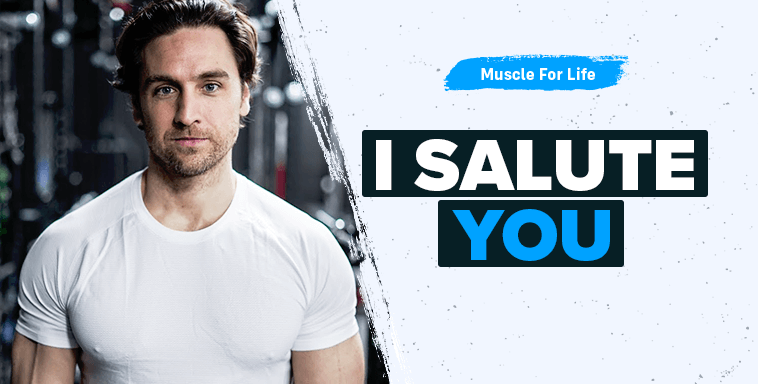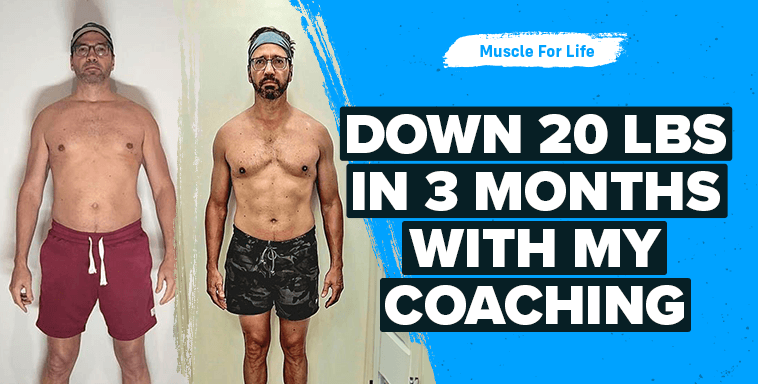[ad_1]
Many new weightlifters are shy of the deadlift.
The main reason is they simply don’t understand the exercise. For example, many don’t know what a deadlift is, what it works, or why it’s beneficial.
Many seasoned weightlifters grapple with questions about the deadlift, too.
They wonder whether you can squat and deadlift on the same day, what the best deadlift alternatives are, and whether the squat or deadlift has more merit.
Let’s clear up some of this confusion.
In this article, you’ll learn science-based answers to the top 10 questions I get asked about the deadlift.
1. What is a deadlift?
The deadlift is a compound exercise that trains the muscle of your posterior chain (the muscles on the back of your body), particularly your back, glutes, and hamstrings.
It involves bending over and lifting a “dead” weight (typically a barbell) off the floor until you’re standing upright, then reversing the movement to return the weight to the floor.
2. What does the deadlift work?
The deadlift trains all of the muscles of your posterior chain, including the lats, traps, spinal erectors, glutes, hamstrings, and calves. It also trains several other muscle groups across the rest of your body, like the quads, forearms, core, and shoulders.
That said, the deadlift doesn’t train all of these muscles equally. Instead, it’s best suited to building your spinal erectors, glutes, traps, hamstrings, core, and forearms and typically isn’t as effective for developing the other muscle groups listed above.
3. What are the deadlift’s benefits?
The main benefits of the deadlift are:
- It trains several major muscle groups across your entire body, making it exceptionally efficient (it does the work of several other exercises).
- It allows you to lift heavy weights and progress regularly, which is ideal for gaining size and strength.
- It may reduce lower-back pain.
- It boosts athletic performance.
- It mimics movements we do in everyday life, strengthening the muscles involved and making day-to-day tasks easier.
4. Are deadlifts worth it?
Some say that it’s not worth doing deadlifts unless you’re a competitive strength athlete.
They argue that the risk of serious injury or burnout is too high and that it simply isn’t necessary for getting fit and strong—you can easily replace it with safer exercises that train all of the same muscles and perhaps get better results.
I mostly disagree.
When performed correctly and as part of a well-designed strength training program, the deadlift is safe for most of us.
Claims that deadlifting “overloads” your CNS (central nervous system) are also exaggerated. Deadlifting is hard, but it doesn’t produce a meaningful amount of CNS fatigue, so it’s not something recreational weightlifters need to worry about.
And while it’s true that the deadlift isn’t essential for building a great physique, it does train nearly every muscle in your body, making it highly efficient. That is, it allows you to train several major and minor muscle groups across your entire body in a fraction of the time it would take to train them with isolation exercises.
5. How much should I deadlift?
Specifying how much you should deadlift as it depends on your weight, experience level, and sex.
For example, the average 200-pound man with 5 years of weightlifting experience can lift significantly more than the average 100-pound man who’s only just started weight training.
If you’re a beginner, don’t compare your numbers with others. Focus on learning proper deadlift form and getting stronger than you were the previous week, month, or year. In other words, compete against yourself and not the ruck of other deadlifters.
That said, if you’re still curious how your numbers stack up against other people who are similar to you or you just want a milestone to shoot for, check out the deadlift strength standards in this article:
These Are the Best Strength Standards on the Internet
6. How much does a deadlift bar weigh?
A standard Olympic barbell—the kind you find in most commercial gyms—weighs 45 pounds.
However, specialty deadlift bars also exist, and they may weigh slightly more or less.
7. Can you deadlift with dumbbells?
Yes.
The dumbbell deadlift is the same as the barbell deadlift, except you use a pair of dumbbells instead of a barbell.
The dumbbell deadlift is a good starting point for many new weightlifters because it allows you to deadlift with weights lighter than a barbell (45 pounds).
The only downsides of using dumbbells are that they’re much smaller than barbell weight plates, which means you have to bend down further to rest them on the floor. This can make deadlifting awkward, especially as the weights get heavy, and may encourage you to let your hips sink too low, which isn’t the best position to pull from.
Dumbbells also move independently, which can make lifting them in a straight vertical line over your midfoot during each rep more challenging.
That’s why I recommend the barbell deadlift over the dumbbell deadlift for most people.
8. Deadlift vs. Squat: Which is better?
Neither is better or worse than the other.
The deadlift and squat are both excellent exercises that train many of the same major muscle groups across your entire body. However, there are differences in which muscles each emphasizes.
For example, while both train all your lower-body muscles, the squat trains the quads more than the deadlift, and the deadlift emphasizes the hamstrings more than the squat. The deadlift also trains your back muscles (especially your lower back and traps) more than the squat.
In other words, the squat and deadlift are somewhat complementary, which is why improving one boosts your performance on the other and vice versa.
That’s why a squat vs. deadlift comparison doesn’t make sense. Instead, you’ll likely benefit from including both in your program.
There are several ways to do this, but my favorite ways are to include the deadlift in a back or pull workout at the beginning of the week and the squat in a leg or lower-body workout later in the week.
This is how I personally like to organize my training, and it’s similar to the method I advocate in my fitness books for men and women, Bigger Leaner Stronger and Thinner Leaner Stronger.
(And if you’d like even more specific advice about organizing your training to reach your health and fitness goals, take the Legion Strength Training Quiz, and in less than a minute, you’ll know the perfect strength training program for you. Click here to check it out.)
9. Can you deadlift and squat on the same day?
Yes, but most people shouldn’t for a few reasons.
First, the deadlift and squat are highly fatiguing and train many of the same muscles—the hamstrings, glutes, and lower back in particular.
Doing both in the same workout will prevent you from performing at your best on whichever you do second since you’ll already be fatigued, limiting the strength- and muscle-building potential of the latter exercise.
Second, both exercises involve lifting heavy weights and placing your body in potentially dangerous positions. Performing either while tired increases the odds of using improper form, increasing your risk of injury.
As such, it’s usually best to do the squat and deadlift in separate workouts at least a day or two apart.
For example, you could do the deadlift as part of a back, pull, or upper-body workout early in the week and the squat as part of a leg or lower-body workout later in the week.
The only exceptions to this rule are the following:
- Time-pressed people: If you only have time for one weekly workout but want to include the squat and deadlift in your program, doing them in the same workout is the only solution. In this case, I’d recommend squatting first and deadlifting second.
- Experience weightlifters. If you’ve been weightlifting for 2-to-3 years, you generally won’t get very sore from workouts and you’ll be able to better maintain your technique even if you’re slightly fatigued. Thus, you may find that you can deadlift and squat in the same workout without much of a dent in your performance.
- Competitive powerlifters: During competition, powerlifters must deadlift after squatting. Practicing this by doing deadlifts and squats on the same day in training allows you to prepare for how it feels to do one after the other in competition. It should also help you gauge how much you can deadlift after squatting.
10. What’s the best deadlift alternative?
It depends.
If you’re weary of the conventional deadlift and want to spice up your training with a different variation, the sumo, trap-bar, and Romanian deadlifts are all good options.
The sumo and trap-bar deadlifts are also worthy alternatives to the conventional deadlift if you have lower-back issues, since both place less stress on your spine.
If a previous injury prevents you from doing deadlifts of any kind or you simply don’t enjoy deadlifting but want to train the same muscles, a combination of exercises works best.
For instance, you could use the barbell, dumbbell, or Pendlay row to train your upper back; the rack pull, weighted back extension, or barbell good morning to train your lower back and glutes; and the lying, seated, or Nordic hamstring curl to train your hamstrings.
+ Scientific References
- NOE DA, MOSTARDI RA, JACKSON ME, PORTERFIELD JA, ASKEW MJ. Myoelectric Activity and Sequencing of Selected Trunk Muscles During Isokinetic Lifting. Spine. 1992;17(2):225-229. doi:https://doi.org/10.1097/00007632-199202000-00018
- Lind J. A kinematic, kinetic and electromyographic analysis of 1-repetition maximum deadlifts. Ubguse. Published online 2014. doi:http://hdl.handle.net/2077/36235
- Camara KD, Coburn JW, Dunnick DD, Brown LE, Galpin AJ, Costa PB. An Examination of Muscle Activation and Power Characteristics While Performing the Deadlift Exercise With Straight and Hexagonal Barbells. Journal of Strength and Conditioning Research. 2016;30(5):1183-1188. doi:https://doi.org/10.1519/jsc.0000000000001352
- Lee S, Schultz J, Timgren J, Staelgraeve K, Miller M, Liu Y. An electromyographic and kinetic comparison of conventional and Romanian deadlifts. Journal of Exercise Science & Fitness. 2018;16(3):87-93. doi:https://doi.org/10.1016/j.jesf.2018.08.001
- Garceau L, Lutsch B, Gary A, Szalkowski C, Wurm B, Ebben W. HAMSTRINGS, QUADRICEPS, AND GLUTEAL MUSCLE ACTIVATION DURING RESISTANCE TRAINING EXERCISES. ISBS – Conference Proceedings Archive. Published online 2010. Accessed June 2, 2023. https://ojs.ub.uni-konstanz.de/cpa/article/view/4415
- ESCAMILLA RF, FRANCISCO AC, KAYES AV, SPEER KP, MOORMAN CT. An electromyographic analysis of sumo and conventional style deadlifts. Medicine & Science in Sports & Exercise. 2002;34(4):682-688. doi:https://doi.org/10.1097/00005768-200204000-00019
- Krings BM, Shepherd BD, Swain JC, et al. Impact of Fat Grip Attachments on Muscular Strength and Neuromuscular Activation During Resistance Exercise. Journal of Strength and Conditioning Research. 2021;35(1):S152-S157. doi:https://doi.org/10.1519/jsc.0000000000002954
- Hamlyn N, Behm DG, Young WB. Trunk Muscle Activation During Dynamic Weight-Training Exercises and Isometric Instability Activities. The Journal of Strength and Conditioning Research. 2007;21(4):1108. doi:https://doi.org/10.1519/r-20366.1
- Uknowledge U, Luke A, Beggs. COMPARISON of MUSCLE ACTIVATION and KINEMATICS COMPARISON of MUSCLE ACTIVATION and KINEMATICS during the DEADLIFT USING a DOUBLE-PRONATED and during the DEADLIFT USING a DOUBLE PRONATED and OVERHAND/UNDERHAND GRIP OVERHAND/UNDERHAND GRIP. https://uknowledge.uky.edu/cgi/viewcontent.cgi?article=1085&context=gradschool_theses
- Berglund L, Aasa B, Hellqvist J, Michaelson P, Aasa U. Which Patients With Low Back Pain Benefit From Deadlift Training? Journal of Strength and Conditioning Research. 2015;29(7):1803-1811. doi:https://doi.org/10.1519/jsc.0000000000000837
- Nigro F, Bartolomei S. A Comparison Between the Squat and the Deadlift for Lower Body Strength and Power Training. Journal of Human Kinetics. 2020;73(1):145-152. doi:https://doi.org/10.2478/hukin-2019-0139
- Barnes MJ, Miller A, Reeve D, Stewart RJ. Acute neuromuscular and endocrine responses to two different compound exercises. Journal of Strength and Conditioning Research. Published online July 2017:1. doi:https://doi.org/10.1519/jsc.0000000000002140
- Cholewicki J, McGill SM, Norman RW. Lumbar spine loads during the lifting of extremely heavy weights. Medicine and Science in Sports and Exercise. 1991;23(10):1179-1186. https://pubmed.ncbi.nlm.nih.gov/1758295/
- Swinton PA, Stewart A, Agouris I, Keogh JW, Lloyd R. A Biomechanical Analysis of Straight and Hexagonal Barbell Deadlifts Using Submaximal Loads. Journal of Strength and Conditioning Research. 2011;25(7):2000-2009. doi:https://doi.org/10.1519/jsc.0b013e3181e73f87
[ad_2]
Source link



